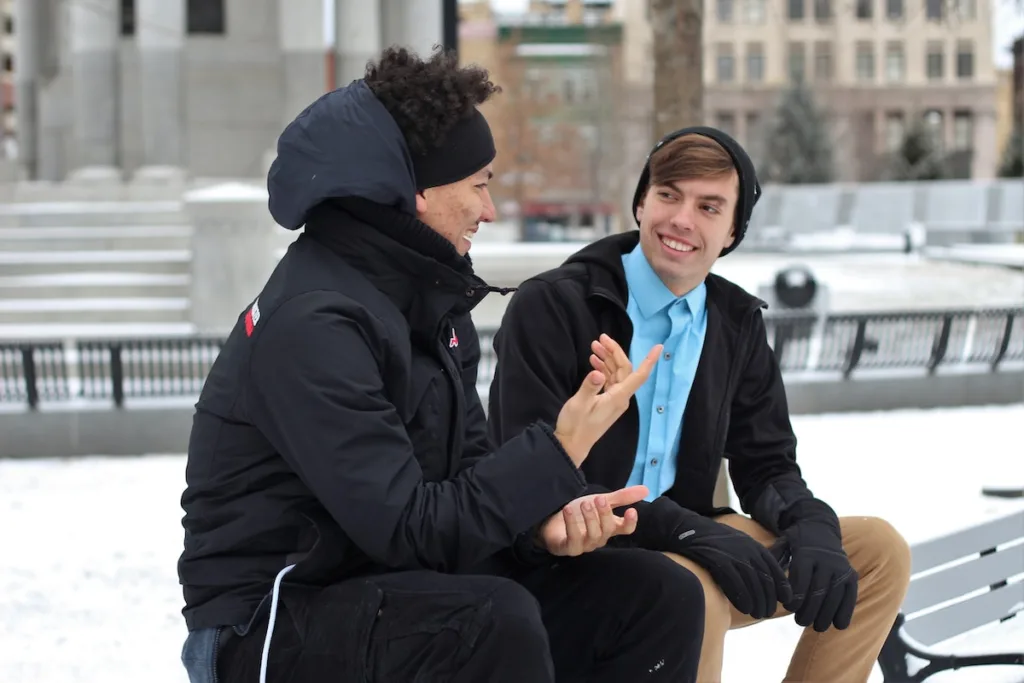Body language refers to the nonverbal communication that we use through our physical movements, gestures, facial expressions, and postures. It can convey emotions, attitudes, and intentions without the use of words, and is an important aspect of interpersonal communication.
Is understanding body language important for teenage girls?
Yes, understanding body language can be important for teenage girls as it can help them to better interpret the emotions and intentions of others in social situations. It can also help them to communicate more effectively, both verbally and non-verbally, and to build stronger relationships. Additionally, understanding and being aware of their own body language can also be beneficial, as it can help them to project confidence and assertiveness, and to better understand how others perceive them.

Is body language important for sports people?
Yes, body language can be important for sports people. In sports, body language can convey confidence, dominance, and control to opponents, which can have a psychological impact on the outcome of the game. On the other hand, negative body language, such as slouching, lack of eye contact, and crossed arms, can convey a lack of confidence and hesitation. Body language can also communicate intent and give cues to teammates about one’s position, movements, and actions, which can be especially important in team sports such as soccer, basketball, and volleyball.
Understanding and controlling one’s own body language, as well as being aware of the body language of others, can therefore be important for sports people to perform at their best.
What body language do rugby players watch out for?
Rugby players often watch out for several key aspects of body language in order to gain an advantage on the field. Some of the body language that rugby players pay attention to include:
- Eye contact: A player’s gaze can give away their intentions and where they are looking can indicate the direction of the next play.
- Posture: The way a player stands and moves can give clues about their level of confidence, whether they are ready to receive a pass or make a tackle, and their position on the field.
- Facial expressions: A player’s facial expressions can convey emotions such as determination, frustration, and fear, which can impact the outcome of the game.
- Shoulder and arm movements: Rugby players also pay attention to the movements of their opponents’ shoulders and arms to determine their intended direction of movement, and to prepare for tackles or blocks.
- Foot placement: Foot placement can also be a key indicator of a player’s intentions and can give cues about the direction of a run or a pass.

By being aware of these elements of body language, rugby players can gain an advantage by anticipating their opponents’ moves and making strategic decisions on the field.
What is considered to be positive body language?
Positive body language refers to nonverbal cues that communicate confidence, approachability, and positive emotions. Some examples of positive body language include:
- Smile: A genuine smile can convey happiness and friendliness.
- Open posture: Standing with arms uncrossed and facing the person you’re talking to shows that you are approachable and interested.
- Eye contact: Making and maintaining eye contact can convey confidence, honesty, and interest.
- Nodding: Nodding while someone is speaking shows that you are paying attention and actively engaged in the conversation.
- Leaning in: Leaning forward towards the person you’re talking to shows that you are interested and involved in the conversation.
- Relaxed stance: Standing or sitting with a relaxed posture can convey comfort and confidence.
Using positive body language can help build rapport and create a positive impression in social and professional interactions.
What is negative body language?
Negative body language refers to nonverbal cues that communicate discomfort, disinterest, and negative emotions. Some examples of negative body language include:
- Crossed arms: Crossed arms can indicate defensiveness, discomfort, or disapproval.
- Lack of eye contact: Avoiding eye contact or looking down can convey disinterest, dishonesty, or shame.
- Frown: A frown can indicate disappointment, anger, or sadness.
- Slouching: Slouching can indicate boredom, lack of confidence, or disinterest.
- Shaking head: Shaking one’s head can indicate disagreement, disbelief, or frustration.
- Fidgeting: Fidgeting with hands or feet can indicate nervousness, discomfort, or boredom.
Negative body language can create a negative impression and harm communication in social and professional interactions. It is important to be aware of both positive and negative body language to communicate effectively.
How can I learn to read body language better?
Here are some steps that can help you improve your ability to read body language:
- Observe: Pay attention to the nonverbal cues of others during conversations and other interactions. Focus on facial expressions, gestures, posture, and eye contact.
- Research: Study books, articles, and videos about body language and its various cues. This can help you understand the different signals that people send through their nonverbal communication.
- Practice: Try to interpret the body language of people in your everyday life and reflect on how accurate your interpretations were.
- Get feedback: Ask others for feedback on your own body language and ask them to point out any nonverbal cues that you may be unaware of.
- Be aware of cultural differences: Keep in mind that nonverbal cues can vary across cultures, so it is important to be aware of these differences when interpreting the body language of others.
By following these steps, you can improve your ability to read body language and become more effective in your social and professional interactions.

Does sport help you understand body language better?
Yes, participating in sports can help improve your understanding of body language. Sports often require quick and accurate interpretation of body language to anticipate an opponent’s move or make split-second decisions on the field. This can help develop your observation skills and improve your ability to read nonverbal cues.
In sports, understanding the body language of your opponents can give you a competitive edge, as you can anticipate their actions and make strategic decisions. Additionally, being aware of your own body language can help you convey confidence, control, and positive emotions on the field, which can have a positive impact on your performance.
Therefore, participating in sports can be a useful way to improve your understanding of body language and develop your nonverbal communication skills.
Can I control my body language?
Yes, you can control your body language to a certain extent. By being aware of your nonverbal cues and making conscious choices about how you present yourself, you can influence the impression you make on others.
Here are some ways to control your body language:
- Practise good posture: Stand and sit up straight to convey confidence and approachability.
- Make eye contact: Maintaining eye contact during conversations can show that you are interested and engaged.
- Use gestures: Appropriate use of gestures can enhance your communication and convey enthusiasm and energy.
- Smile: A genuine smile can convey friendliness and positivity.
- Control your facial expressions: Avoid expressions that convey negative emotions like anger, frustration, or sadness.
- Manage nervous habits: Try to minimise nervous habits like fidgeting, foot tapping, or nail biting, which can convey nervousness or discomfort.
By being mindful of your body language and making conscious choices about how you present yourself, you can increase your ability to control and influence the impression you make on others.

